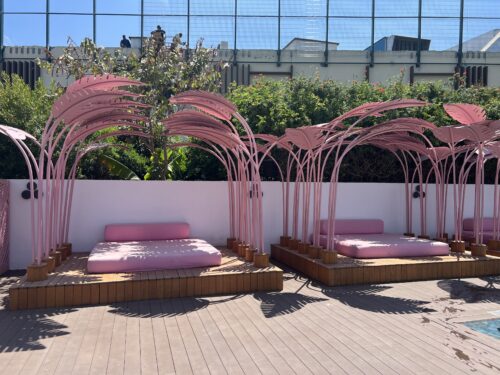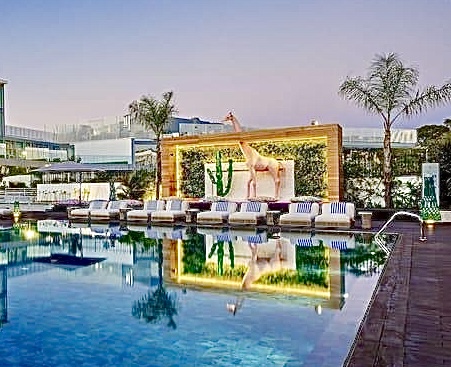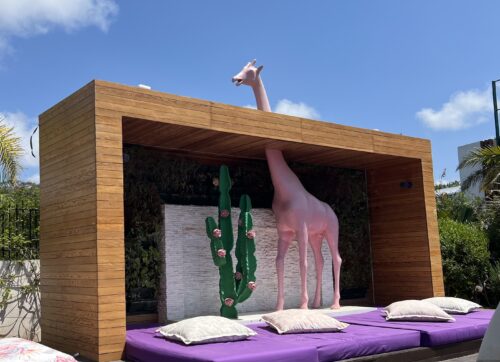7th May
“Explore the rich cultural heritage of the city of Tangier! Influential figures like Matisse and Paul Bowles have been inspired by its Bohemian atmosphere, creating an artistic and intriguing legacy. This white city is perched on a small hill, watching over Europe and Africa, the Atlantic and the Mediterranean. The contrasting architecture reflects the many powers that have occupied the city over the centuries, including the Spanish, English, and French. Explore the old town, the winding streets of the medina, Mendoubia Gardens, the historic synagogue of the Jewish quarter and the American Legation with house museum and courtyard”
It all sounded great but not for us. The day started early and ended late and involved a lot of walking. By now both of us were definitely feeling unwell and decided to have a day of rest by the pool and lazing around with lots of naps. We will probably never get back to Tangier and what we did see of it driving around looked interesting but that’s the way it is. 🙁
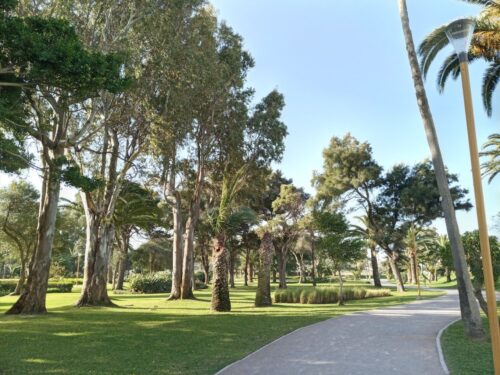
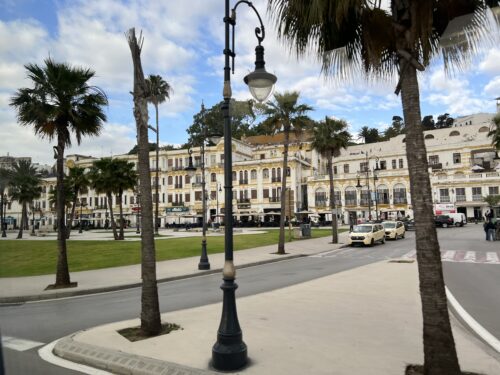
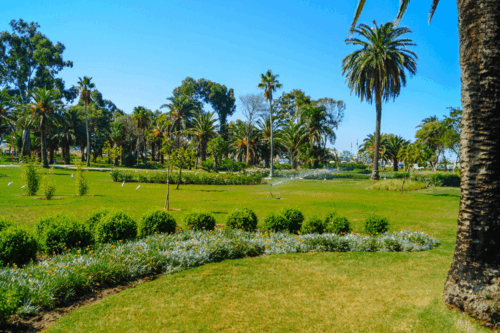
We had heard rumours of a hidden Speakeasy in the hotel, and had caught a glimpse when we were group dining the night before, so, with our appetite not completely gone, we went in search of some dinner. We were directed down a corridor where there was a plain door with a knocker.
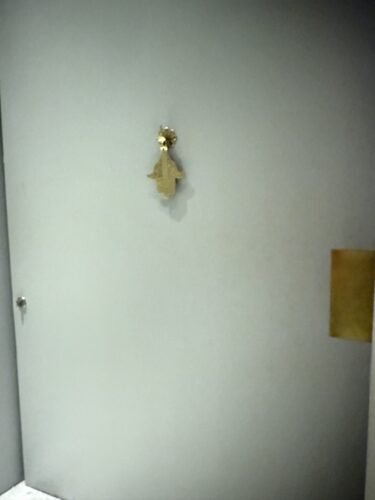
All you had to do was knock three times!
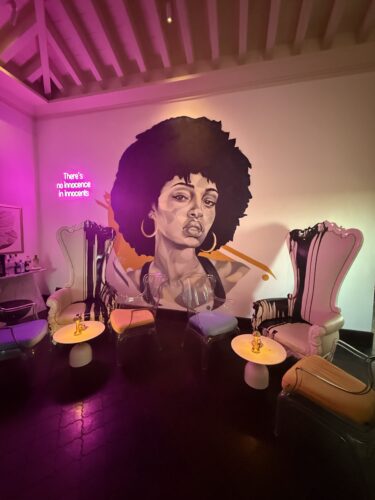

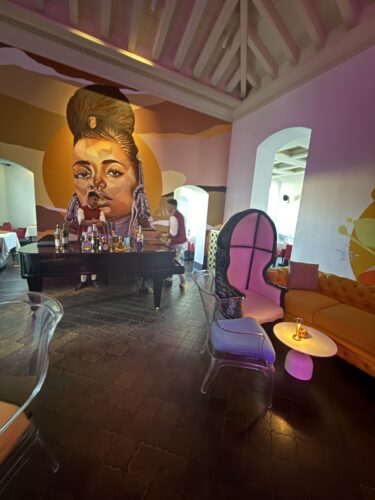
and were ushered in and served cocktails and a traditional Moroccan feast. Hade we been in better form we would have done it justice but we did our best
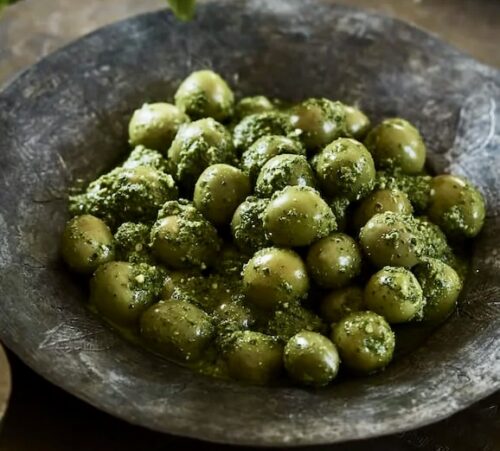
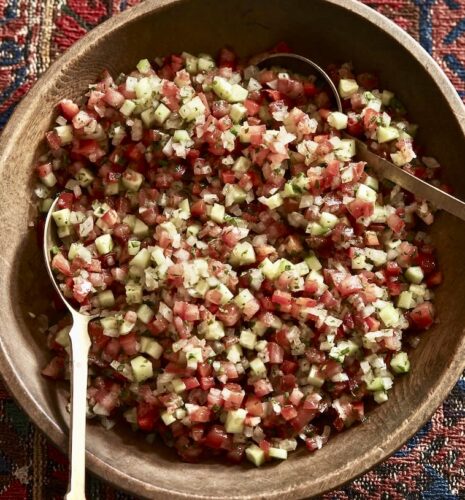
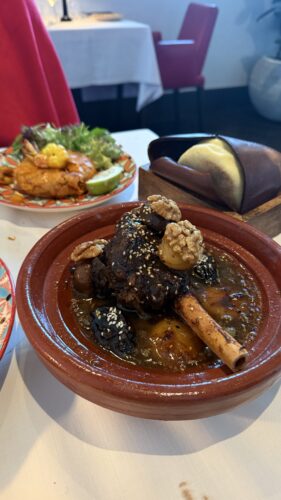
As we were heading back to our room we ran into some of our fellow travellers. They hadn’t been back long and looked exhausted. We’d made the right decision.
8th May
Off to Fes today with a stop in the famous ‘Blue City’ of Chefchaouen. Founded in 1471, it became a fortress from which Moorish exiles fought off Portuguese invasions of northern Morocco. We visited the remains of the original fortress, or kasbah, still standing today then wandered around the streets of the old town, where the buildings are painted striking shades of blue.
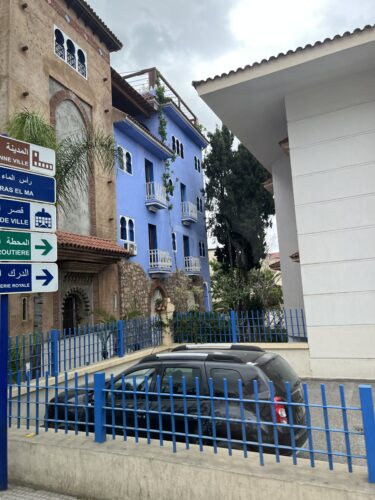
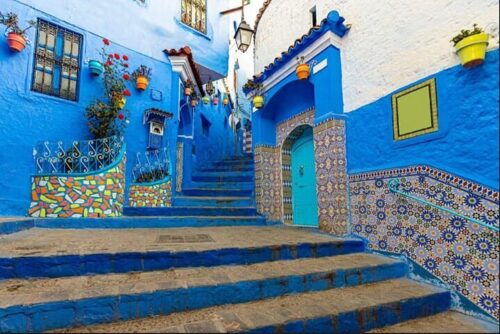
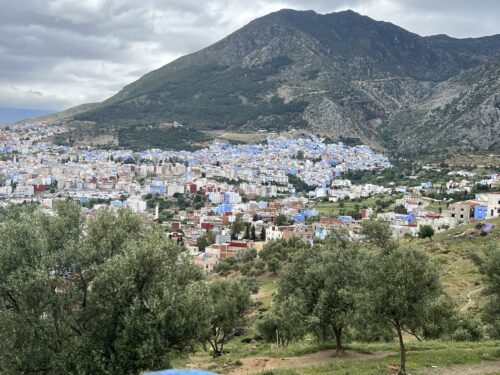
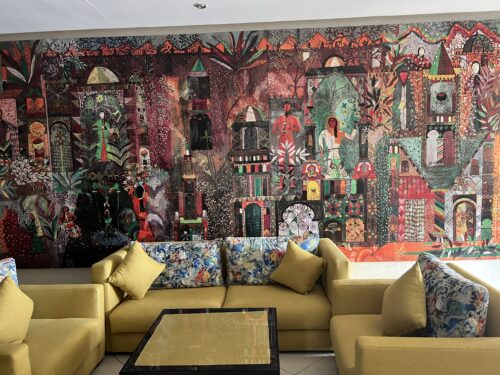
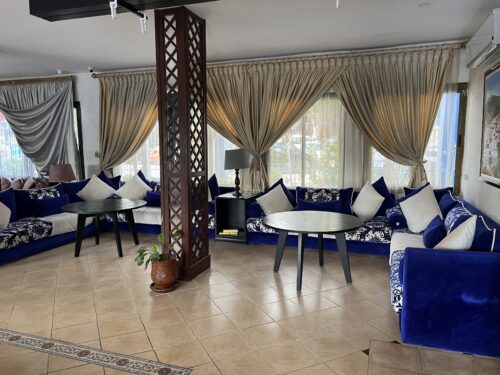
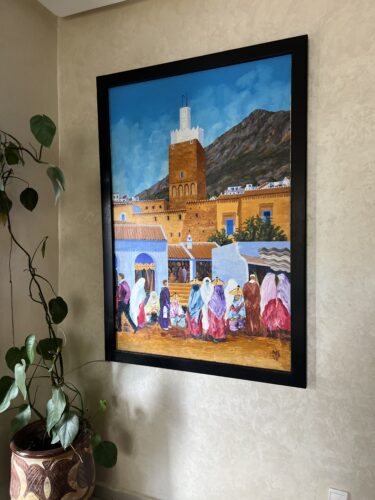
We called in to one of the blue hotels for a drink. The decor was interesting and I thought attractive.
We later joined the others for a smorgasbord lunch. There were a couple of other buses there too and lots of food. I wasn’t hungry and the food was heavy and a bit greasy so I didn’t eat much. About a hour into our drive to Fes I started to get violent stomach cramps and had to get the bus to pull over to a rather dilapidated service station.
Our guide was very concerned that the facilities would not be up to scratch and he wasn’t wrong! A dirty cubicle with a hole in the floor and a tap and a bucket. A couple of our fellow travellers had come down to assist me and I made it rather shakily back to the bus. Deep breathing and a few prayers got me to Fes without further incident but that was the final straw. Ed was really miserable with what he described as ‘the worst cold he had ever had in his life’ and I couldn’t face another two days travel by bus.
We told Matthew we would be leaving the tour and would meet them in Marrakesh. He, Xavier and Riad put their heads together and came up with a Plan B.

May 9th and 10th
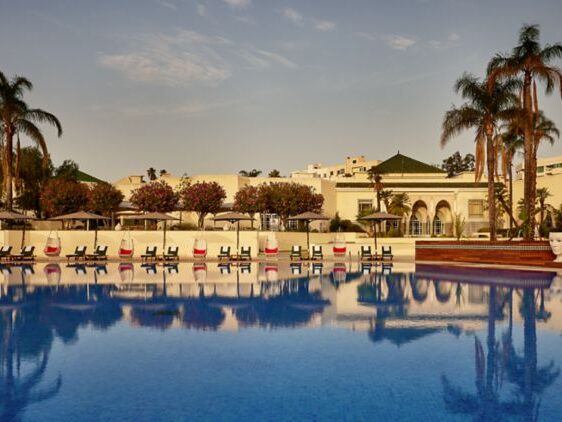
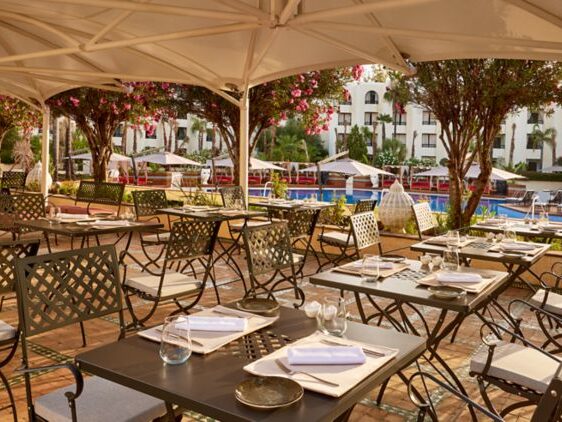
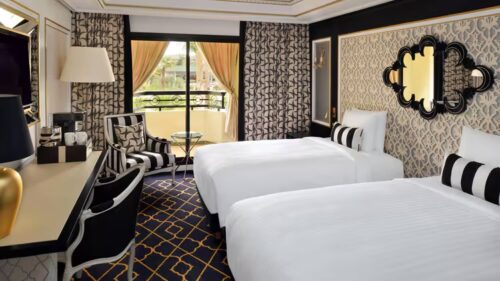
The next day we spent in the hotel with lots of lying in the sun for Ed and a light diet for me. The day after they organised a private car with driver to pick us up from the hotel about 10 o’clock and drive us to Rabat for an early check in and to meet up with the others.
Promptly at 10 o’clock and obviously well briefed, a solicitous Yassine arrived and shortly after we were ensconced in a comfortable back seat with bottles of cold water and our luggage dealt with.
Whilst we missed out on guided tours of Fes and Rabat we learned a great deal about Morocco over the next two days. Yassine was a Berber, born in an oasis in the desert. He learnt his English working on film sets for, mainly, American companies. He also learnt to drive – a big step up for a boy from the desert. He worked in the film industry for a number of years during the shooting of, amongst others, The Mummy, Mission Impossible and Gladiator.
Realising that the tourism industry had a big future in Morocco he studied and became a licensed tour guide. He speaks three languages and is qualified to do city and desert guiding. Morocco is very strict about who can guide the tourists and doing so without a proper license can lead to imprisonment. He mainly does private work now with individuals or groups.
We asked him about the King. It was fairly obvious from talking to guides and hotel staff that the King was well respected and held in high regard by everyone we spoke to. His photo is everywhere, in pride of place, even in small shops. Yassine explained that the King was very progressive and determined to improve Morocco and the lives of his people. He is an astute businessman and has businesses operating across industries like banking, mining, real-estate, tourism, insurance, telecommunications plus substantial land holdings throughout Africa.
He had the foresight to invest heavily in the Port of Tanger-Med which is a crucial hub for global trade, particularly in container handling, and is the largest port in Africa and the Mediterranean. The port is a key link in the east-west maritime trade route and a vital link in global trade between Africa, Europe, Asia, North America and South America. Everything that goes through the Port adds to Morocco’s coffers and, like our guide and tour bus, every job that can be done by a Moroccan is done by a Moroccan.
A number of people proudly told us that the King ultimately contained the Arab Spring protests by implementing some reforms and that Morocco was not very affected unlike other countries which were now much worse off. This appears to be generally if not completely true. Certainly none of the King’s power was conceded.
My father always said, rather facetiously, that the best form of government is a benevolent dictatorship citing Singapore under Lee Kuan Yew. Maybe it is in this case. Certainly those who had been in Morocco five or more years ago say it has changed beyond recognition – for the better. The king has introduced progressive reforms that would never have passed if the country was a democracy, and he tries to counter the very strong religious right without antagonising it but gradually introducing reforms, which is the most pragmatic approach possible.
His long-term vision and programs (green morocco program, industrial acceleration plan, the transition into renewable energy…) have had a lasting impact on the country and the stability the comes from having a monarchy encouraged many big companies to invest in the country.
Rabat is the centre of government and the drive in was very attractive with wide avenues and green landscaping. We passed the entrance to one of the King’s palaces (he has a number of palaces in the Royal compound – this one was for visiting dignitaries). It was very well guarded – we noticed security was very tight all over Morocco.
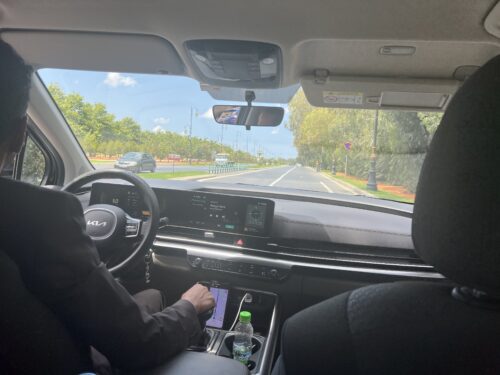
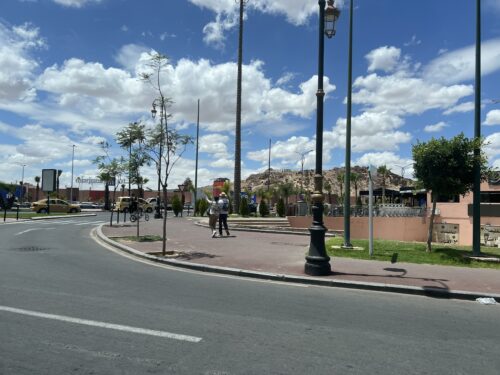
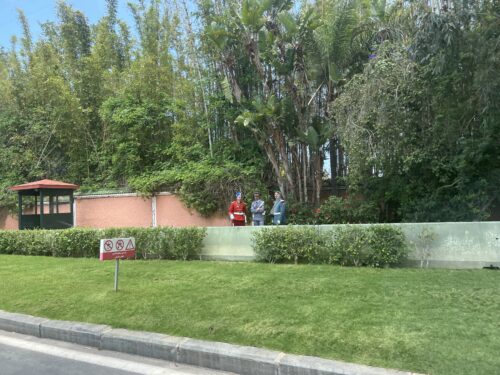
I took a photo of the entrance and the guards. Yassine was a bit uncomfortable and told me that it was illegal to take photos of the police, the guards and the military. However he didn’t think they noticed and so we made it safely to our hotel to continue our recuperation.
